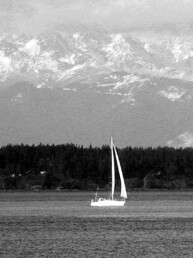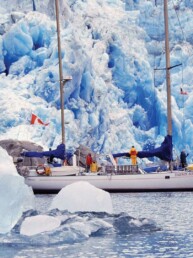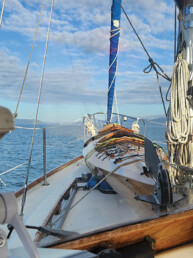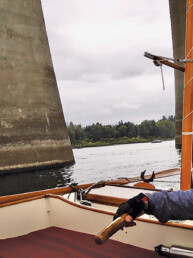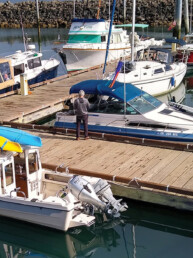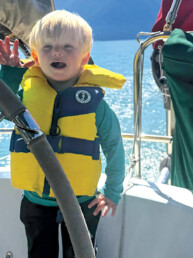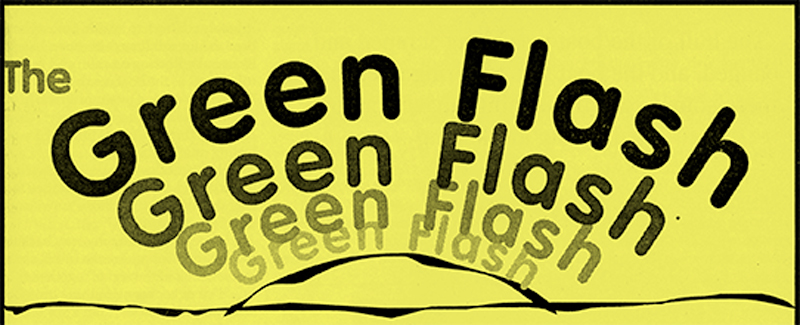 From the January 1999 issue of 48° North by William Galvani.
From the January 1999 issue of 48° North by William Galvani.
Ulysses never saw the green flash in his years of wandering at sea, or if he did, Homer never mentioned it. A brief color transformation at sunset didn’t rate highly compared to other more urgent phenomena such as Sirens, the Cyclops, and Scylla & Charybdis.
Most sailors are in the same boat, so to speak, with Ulysses: they’ve heard of the green flash but they’ve never seen it. There are good reasons they haven’t. The green flash is the momentary change in color of the top portion of the sun when it’s on the horizon. Though it is real (unlike Ulysses’ tormentors), it’s occurrence depends on the proper combination of several factors that rarely coincide, including a clear, pollution-free day, and a view of the horizon which is unobstructed and almost parallel to it.
The phenomena results from the refraction of the sun’s rays at the horizon by the atmosphere. As the sun sinks, layers of the atmosphere, like a prism, break its light into different colors. Red light sets with the sun, blue light is dispersed or scattered, and yellow light is absorbed. Only the green light shines through for a few brief seconds. The green flash occurs at sunset or sunrise but is more often observed at day’s end simply because more people are awake to see it.
Well-known among sailors and those who live by the sea, the green flash was first mentioned in 1837 by Captain Back of HMS Terror while exploring the Arctic. Since then it has appeared in literature, as it does on the horizon, only occasionally, most notably in Herman Wouk’s 1965 novel Don’t Stop the Carnival. Today, the name graces bars, restaurants, and potent drinks, particularly in the Caribbean.
The history of the green flash was unknown to me when I first sailed as a teenager. Experienced sailors bragged about seeing it, and my youthful mind made its sighting a rite of passage which would transform me from a messer-about-in-boats to old salt.
But the green flash proved an element of nature that cannot be summoned on demand. Over the next thirty years at sea, on everything from 36-foot sloops to aircraft carriers, I tracked the progress of the sun as it approached the horizon, flicking my eyes toward and away from the red glow, waiting for the last perfect moment when it would turn green.
It never happened, and I began to regard the green flash as a myth, or worse, a deliberate hoax, one of the initiation torments inflicted by old hands on greenhorns.
And then, unexpectedly, a career’s worth of frustration reversed itself. I had gone to San Diego for a business meeting which included an evening event at the La Jolla Museum of Contemporary Art. The museum has an impressive waterfront location looking west over the Pacific. As sunset approached, fifty or so conventioneers moved to the deck of the museum, enjoying the warm air, cloudless sky, and unhindered view of the horizon. I was munching on hors d’ouvres and talking with a friend from Arizona as the sun descended to the horizon and sank into the Pacific.
When the top of the arc neared the horizon, it filled with a beautiful liquid neon green, glowing like an over-achieving lightening bug for two or three seconds before vanishing.
“Did you see that?” my friend asked. “The sun turned green.” Yes! I thought, a witness! “That was the green flash,” I said. “What’s the green flash?” she asked.
My Arizona friend had not only never sailed, she’d never been to sea and never heard of the green flash. So much for rites of passage and a lifetime of nautical experience.
Now when I’m sailing and the green flash comes up, I can say casually, “Oh yeah, I’ve seen it. Haven’t you?” I’m not going to add that my sighting occurred from the deck of the Museum of Contemporary Art. I hope Ulysses will understand.
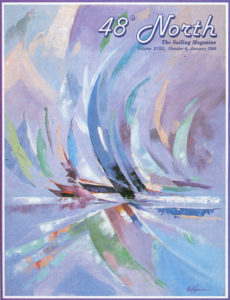
Editor
48° North Editors are committed to telling the best stories from the world of Pacific Northwest boating. We live and breathe this stuff, and share your passion for the boat life. Feel free to keep in touch with tips, stories, photos, and feedback at news@48north.com.

